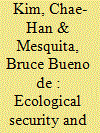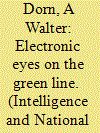| Srl | Item |
| 1 |
ID:
142092


|
|
|
|
|
| Summary/Abstract |
The quality of the ecological environment and security are trans-national and national public goods, respectively. Conceptually, there are three different causal relationships between ecology and security. First, the improvement of security may make the ecological environment better in such cases as détente, followed by environmental cooperation while the degeneration of security deteriorates the ecology in such cases as war. Second, a military confrontation may restore natural ecological systems in such cases as the Korean Demilitarized Zone. Third, ecological cooperation can result in politico-military cooperation while environmental conflict can instigate military conflict. Though the causal path from ecology to security is limited, it needs to be considered as a means to build up security and confidence. A peace park may belong to this category. The Park Geun-hye government has proposed a World Eco-Peace Park to be built inside the Korean DMZ. There is no precedent for the DMZ Peace Park to wholly imitate since no existing peace park was created without some form of prior political and military resolution. The project of the DMZ World Eco-Peace Park should be promoted while considering what facilitates its creation as well as what effect the park will have
|
|
|
|
|
|
|
|
|
|
|
|
|
|
|
|
| 2 |
ID:
131107


|
|
|
|
|
| Publication |
2014.
|
| Summary/Abstract |
The 1974 Cypriot War divided the island of Cyprus into two parts with a narrow demilitarized zone (DMZ) between the opposing Greek Cypriot and Turkish forces. The volatility and violence in this zone, called the 'Green Line', necessitated a constant UN peacekeeping presence that was achieved mainly with manned observation posts (OPs). About 150 of these posts were established by 1975 to maintain stability and prevent flare-ups, including any lethal exchanges between the two sides. By the early 1990s, many of the countries contributing peacekeepers to the United Nations Peacekeeping Force in Cyprus (UNFICYP) had become tired of the stalemate and the lack of progress in negotiations (peacemaking), so they withdrew their troops from the force. This necessitated a reduction in the number of constantly manned OPs from 51 in 1992 to 21 in mid-1993. Further downsizing of UNFICYP by the UN Security Council in 2004 gave rise to a new approach to monitor the DMZ and produce actionable intelligence. Cameras were installed in hot-spots in the Nicosia DMZ and more responsive patrols were introduced as part of the new 'concentration with mobility' concept. This was the first time a UN peace operation used unattended cameras to monitor a demilitarized zone. This article examines the UN's difficulties and successes using the remote cameras, especially during important incidents. Other technologies that aided UNFICYP are also reviewed for lessons that might assist an under-equipped United Nations in its watchkeeping function.
|
|
|
|
|
|
|
|
|
|
|
|
|
|
|
|
| 3 |
ID:
117738


|
|
|